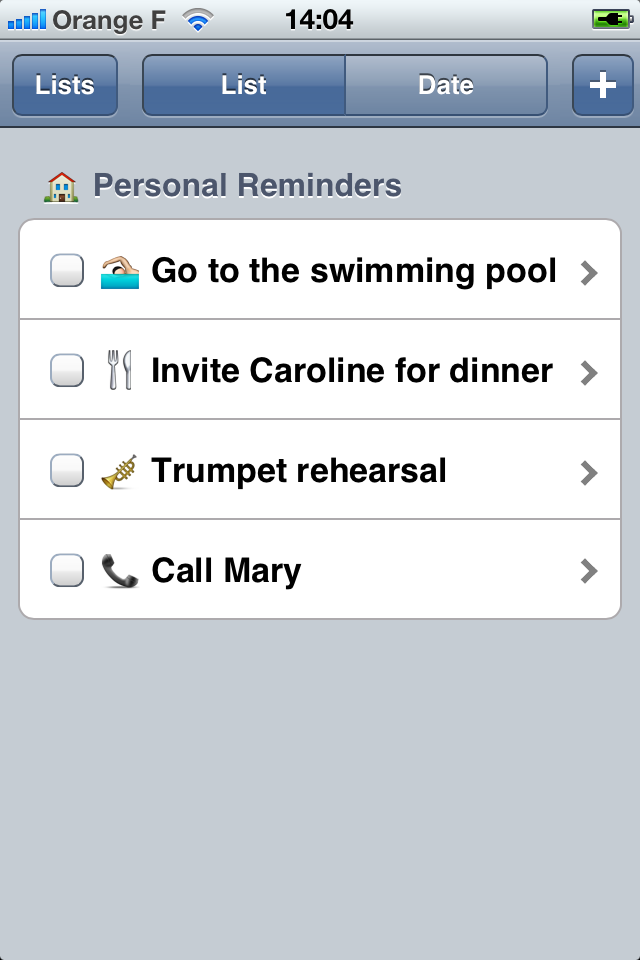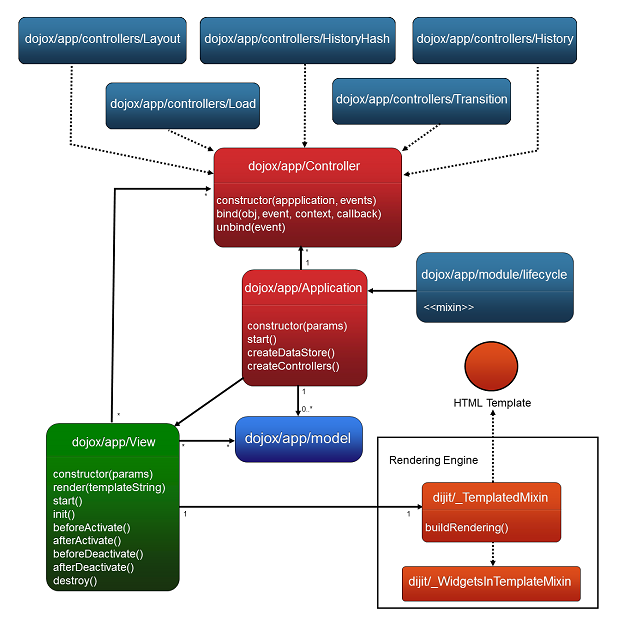dojox/app¶
| since: | V1.7 |
|---|
Foreword: dojox/app is an experimental module and its architecture is still evolving. In particular it was greatly improved between 1.7 and 1.8. It is for now only fully-functional with Webkit-based browsers.
dojox/app is an application framework designed to allow simple configuration of potentially nested views and to facilitate the transitioning between these views. Its main current targets are mobile (phone & tablet) devices but it is not restricted to this and can be used for desktop applications as well. Thanks to dojox/app the applications are easily configurable and buildable for easy and fast deployment.
There are two core modules that will need to work together to accomplish these goals:
dojox/app- A library that provides high-level application controllers, defined by metadata which describes the overall structure and navigation of the application and it’s views.dojox/mvc– An optional library that provides the ability to have view concerns separated from model or data concerns by using simple binding between them so that they can be kept in sync.
The main dojox/app modules¶
dojox/app is built around the following focused core modules:
dojox/app/main is used to create a dojox/app Application object from the JSON configuration. The main responsibilities of dojox/app/main include loading the various controllers & data stores as well as managing the application lifecycle.
dojox/app/View provides a view object in charge of the view rendering and lifecycle. It contains a template string which will be rendered. A view can itself have nested View objects.
dojox/app/Controller a base class for the various application controllers:
dojox/app/controllers/Layouta controller that performs nested view layoutdojox/app/controllers/Loada controller that loads the view templates and view definition modulesdojox/app/controllers/Historya controller that maintains application history using HTM5 history API. This will not work on platforms that don’t support it like IE, Android 3 & 4, iOS 4.dojox/app/controllers/HistoryHashan alternate controller that maintains application history using URL hash. It works on all browsers but has limitations with regard to browser refresh and going back to an URL out of application’s history stack.
dojox/app/model, depending on the application models configuration, is creating either simple or MVC models for the views to bind their widgets to.
dojox/app/module a package containing various modules than can be used in the configuration file to be mixed into the Application object.
The Configuration Object¶
Configuration comes in the form of a basic JSON-like object with several key, pre-defined properties:
id¶
String. The dojox/app application’s id. A global variable with id’s name is created by dojox/app/main.
id: "sampleApp"
description¶
String. The description of the dojox/app application
description: "Sample application that does what is needed"
loaderConfig¶
Object. Dependencies, modules and controllers are loaded using the Dojo AMD loader. This parameter allows to configure the loader itself and specify for example where custom modules can be found. See http://livedocs.dojotoolkit.org/loader/amd#module-identifiers
"loaderConfig" : {
"paths": {
"mypackage" : "can/be/found/here"
}
}
dependencies¶
Array of AMD modules identifiers. When defined at the top level dependencies of the dojox/app application. When defined at view level, dependencies for the view.
"dependencies": [
"dojox/mobile/TabBar",
"dojox/mobile/RoundRect",
"dojox/mobile/TabBarButton",
"dojox/mobile/Button",
"dojox/mobile/RoundRect",
"dojox/mobile/Heading"
]
modules¶
Array of AMD modules identifiers. Modules for the application. Used as the mixins when declaring the Application class in dojox/app/main. They modify the top level behavior of the application, how it processes the config, or any other life cycle. The “dojox/app/module/lifecycle” is automatically mixed into the application you don’t have the explicitly include it.
"modules": [
"mypackage/custom/module"
]
controllers¶
Array of AMD modules identifiers. Controllers for the application. All the controllers defined here will be loaded during application startup to respond to application events and controller the application logic. The “dojox/app/controllers/Load” and “dojox/app/controllers/Transition” are automatically mixed into the application you don’t have the explicitly include them.
"controllers": [
"dojox/app/controllers/History",
"mypackage/custom/appController"
]
stores¶
Object. Dojo stores which are used by dojox/app to setup data models. A store item is an object with a a type and a params property. The type property is the AMD module identifier for the store class to be instantiated. The content of the params property is passed to the store class constructor to build an instance.
"stores": {
"store1":{
"type": "dojo/store/Memory",
"params": { // parameters used to initialize the data store
"data": "modelApp.names"
}
},
"store1":{
"type": "dojo/store/JsonRest",
"params": {
"data": "modelApp.repeatData"
}
}
}
template¶
String. HTML file. When defined at application level defines the application root template. When defined at view level defined the view template.
"template": "application.html"
models¶
Object. Models and their instantiation parameters. A model item is an object with three properties: the model type, the modelLoader and the params. The modelLoader property defines whether an MVC or a simple model must be loaded. The type property defines which class must be used for that model using an AMD module identifier and finally the params property content is passed to the model class constructor to build an instance.
"models": {
"model1": {
"modelLoader": "dojox/app/utils/mvcModel",
"type": "dojox/mvc/EditStoreRefListController",
"params":{
"store": {"$ref":"#stores.namesStore"}
}
},
"model2": {
"modelLoader": "dojox/app/utils/simpleModel",
"params":{
"store": {"$ref":"#stores.namesStore"}
}
}
}
defaultView¶
String. The name of the view to load when the application is initialized.
"defaultView": "home"
defaultTransition¶
String. The default animation type for the view transition.
"defaultTransition": "slide"
views¶
Object. The children views of an application or of a view. Dependencies may be defined on views for optimization and organization purposes. Models might also be defined on views if they are view-specific. Finally a view item as three additional properties: transition for specific view transitions, template for defining the view rendering and finally definition to provide an AMD module to be mixed into the view to control it. AMD modules identifiers starting with “.” will be resolved relative to the application root. All other modules identifiers will be resolved according to the Dojo AMD loader rules and in particular with respect to its configuration provided as part of the loaderConfig attribute. By default if no definition module is specified for a view it is looked up automatically in ”./views/<viewId>.js”. If you don’t want a definition module at all you should specify the “none” value.
"views": {
// simple view without any children views
// views can has its own dependencies which will be loaded
// before the view is first initialized.
"home": {
"dependencies":[
"dojox/mobile/RoundRectList",
"dojox/mobile/ListItem",
"dojox/mobile/EdgeToEdgeCategory"
],
"template": "./views/simple/home.html"
"definition": "./views/simple/home.js "
},
// simple composite view which loads all views and shows the default
"main":{
// all views in the main view will be bound to the user model
"models": [],
"template": "simple.html",
"defaultView": "main",
"defaultTransition": "slide",
// the child views available to this view
"views": {
"main":{
"template": "./views/simple/main.html"
"definition": "none"
},
"second":{
"template": "./views/simple/second.html"
},
"third":{
"template": "./views/simple/third.html"
}
},
"dependencies":[
"dojox/mobile/RoundRectList",
"dojox/mobile/ListItem",
"dojox/mobile/EdgeToEdgeCategory",
"dojox/mobile/EdgeToEdgeList"
]
},
"repeat": {
// model declared at view level will be accessible to this view
// or its children.
"models": {
"repeatmodels": {
"params":{
"store": {"$ref":"#stores.repeatStore"}
}
}
},
"template": "./views/repeat.html",
"dependencies":["dojox/mobile/TextBox"]
}
}
This configuration serves two purposes: configuring the application within the client and acting as a map for building the application for production.
How to use dojox/app¶
As with any Dojo-based web application, it’s important to create your HTML page with a script tag referencing the Dojo loader dojo. Once done you load the main module and provide it with the configuration file as follows:
require(["dojox/app/main", "dojox/json/ref", "dojo/text!./config.json"],
function(Application, json, config){
// startup the application
Application(json.fromJson(config));
});
Upon loading the dojox/app views, stores and models are created and the application lifecycle is started.
Here is a full example of a configuration file:
{
"id": "todoApp",
"name": "ToDo App",
"description": "These is a ToDo sample application based on the Dojo Toolkit and provided under Dojo license.",
"splash": "splash",
"dependencies": [
"dojox/mobile/TabBar",
"dojox/mobile/RoundRect",
"dojox/mobile/TabBarButton",
"dojox/mobile/TextBox",
"dojox/mobile/TextArea",
"dojox/mobile/CheckBox",
"dojox/mobile/ExpandingTextArea",
"dojox/mobile/Button",
"dojox/mobile/RoundRect",
"dojox/mobile/Heading",
"dojox/mobile/ListItem",
"dojox/mobile/RoundRectList",
"dojox/mobile/RoundRectCategory",
"dojox/mobile/Switch",
"dojox/mobile/SimpleDialog",
"dojox/mobile/DatePicker",
"dojox/mobile/Opener",
"dojo/date/stamp",
"dojox/app/widgets/Container",
"dojo/data/ItemFileWriteStore",
"dojox/mvc/EditStoreRefListController",
"dojox/mvc/Repeat",
"dojox/mvc/Group",
"dojox/mvc/Output",
"dojox/mvc/at"
],
"modules": [],
"controllers": [
"dojox/app/controllers/History"
],
"stores": {
"listsDataStore":{
"type": "dojo/data/ItemFileWriteStore",
"params": {
"url": "./resources/data/lists-emoji.json"
}
},
"allitemlistStore":{
"type": "dojo/data/ItemFileWriteStore",
"params": {
"url": "./resources/data/all-items-emoji.json"
}
}
},
"models": {
"listsmodel": {
"modelLoader": "dojox/app/utils/mvcModel",
"type": "dojox/mvc/EditStoreRefListController",
"params":{
"datastore": {"$ref":"#stores.listsDataStore"}
}
},
"allitemlistmodel": {
"modelLoader": "dojox/app/utils/mvcModel",
"type": "dojox/mvc/EditStoreRefListController",
"params":{
"datastore": {"$ref":"#stores.allitemlistStore"}
}
},
"itemlistmodel": {
"modelLoader": "dojox/app/utils/mvcModel",
"type": "dojox/mvc/EditStoreRefListController",
"params":{
"datastore": {"$ref":"#stores.allitemlistStore"},
"query": {"listId": 0}
}
}
},
"defaultView": "items,ViewListTodoItemsByPriority",
"defaultTransition": "fade",
"views": {
"configuration": {
"defaultView": "SelectTodoList",
"defaultTransition": "fade",
"definition": "none",
"views": {
"SelectTodoList": {
"template": "./templates/configuration/SelectTodoList.html"
},
"ModifyTodoLists": {
"template": "./templates/configuration/ModifyTodoLists.html"
},
"EditTodoList": {
"template": "./templates/configuration/EditTodoList.html"
}
}
},
"items": {
"template": "./templates/items.html",
"defaultView": "ViewListTodoItemsByPriority",
"defaultTransition": "fade",
"views": {
"ViewListTodoItemsByPriority":{
"template": "./templates/items/ViewListTodoItemsByPriority.html"
},
"ViewAllTodoItemsByDate":{
"template": "./templates/items/ViewAllTodoItemsByDate.html"
}
}
},
"details": {
"defaultView": "EditTodoItem",
"defaultTransition": "fade",
"definition": "none",
"views": {
"EditTodoItem":{
"template": "./templates/details/EditTodoItem.html"
},
"EditItemRepeat":{
"template": "./templates/details/EditItemRepeat.html"
},
"EditItemRemindMe":{
"template": "./templates/details/EditItemRemindMe.html"
},
"EditItemPriority":{
"template": "./templates/details/EditItemPriority.html"
},
"EditItemList":{
"template": "./templates/details/EditItemList.html"
}
}
}
}
}
The corresponding application looks like the following:

See the todoApp example in Dojo demos installation directory for the full application.
Comparison with dojox/mobile/app¶
First please note that going forward dojox/mobile/app will be deprecated in favor of dojox/app.
The main differences between dojox/app and dojox/mobile/app are the following:
dojox/appenables the model bindingdojox/appuses view structure to enable the nested views using a composite design pattern.dojox/mobile/appwill require additional code for that.dojox/appcontains the layout mechanism to ensure the content at different application/view level work well togetherdojox/mobile/appmanages the navigation history in StageController by using a history stack. Dojox/app provides both HTML5 pushState & history stack for managing the navigation history.
